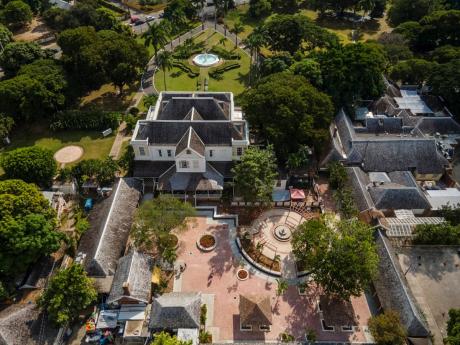NO REGRET
JNHT chairman defends paved Devon House courtyard, says public will appreciate final look
Jamaica National Heritage Trust (JNHT) Chairman Orville Hill has defended his organisation’s decision to approve the design for the new-look Devon House courtyard amid public debate over the changes, which critics say have dealt a severe blow to...
Jamaica National Heritage Trust (JNHT) Chairman Orville Hill has defended his organisation’s decision to approve the design for the new-look Devon House courtyard amid public debate over the changes, which critics say have dealt a severe blow to the historical value and aesthetics of the St Andrew-based property.
In a Gleaner interview on Friday, Hill argued that Devon House was in need of renovation, pointing out that additional space was created for visitors to move around freely.
“You have a greater area that would facilitate easier movement and you have more and more people at Devon House, so you need more space for people to just move around freely without having to bounce into each other as you try to move around the facility,” he said.
The JNHT came under fire on Thursday from noted architect Dr Patricia Green for approving the paving of the lush courtyard. Her comments came after a social-media firestorm over the changes.
Green charged that the JNHT had been derelict in its role in preserving the complex, adding that the board was complicit in the area being “jeopardised”.
But Hill has brushed aside the criticism, arguing that the changes have not compromised the historical value of Devon House.
“The claim that is being made, I am not in agreement with it, and I am fully in support of the development that is taking place,” he told The Gleaner.
He stressed that the Heritage Review Development Committee of the JNHT that reviewed the new design of the courtyard made a recommendation that the board accepted.
Hill indicated that the committee engaged the Kingston and St Andrew Municipal Corporation when it assessed the design.
“It is a holistic approach and not just a single agency making the decision. We need to look at it and make sure that it is within the parameters of the heritage district,” the JNHT chairman said.
“It is really, in the long run, an improvement of the overall facility, and to make it much easier for persons to come to Devon House and really enjoy the facility,” he argued.
Hill pointed out that the development was spearheaded by the Tourism Enhancement Fund (TEF), which had engaged a consultant to design the courtyard.
In a press statement issued Thursday afternoon, the TEF said that the courtyard had dimensions of 0.12 hectare, representing 2.4 per cent of the property.
Asked whether members of the public had an opportunity to make an input in relation to the proposed changes, Hill said, “I am aware that not necessarily with the public, but persons who are operating in the Devon House space, I am sure that they had some consultation with those persons to say this is what we are proposing to do.”
He indicated that those stakeholders at Devon House were in agreement with the proposed changes.
However, Hill sought to assuage disgruntled members of the public that the work on the courtyard was not yet complete, noting that the space was opened for the holiday period.
“By the time the trees and the other greenery are put in and get a chance to grow and come to some level of maturity, I am certain people will see a space that they are more appreciative of,” he said.
The JNHT chairman said that oftentimes, “we don’t have a long-term view of certain developments. We look at what is taking place immediately before our eyes, but usually, there is a long-term view to the development that is taking place”.
He said that drainage was a challenge on the property and with heavy rains, some areas were flooded.
“We all cherish the area and so what we are doing is really just improving the general area,” Hill said.
He added that only one tree was removed from the courtyard.
“That one tree would have been assessed by the Forestry Department and found that it is really unsafe to have that tree because it had aged and was a threat to public safety.”

